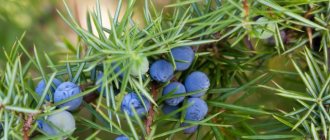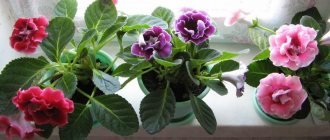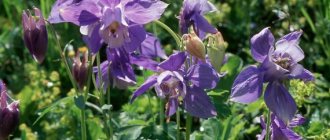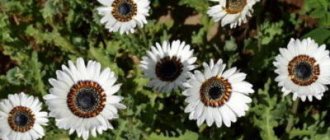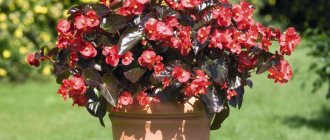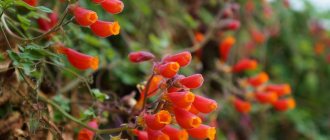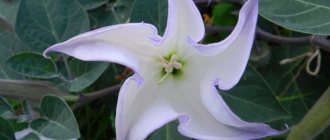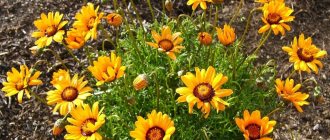Schizanthus (or schizanthus) belongs to the Solanaceae family. Habitat: South America and southern Africa. The plant is beautiful and has long flowering. The culture is externally similar to an orchid, but unlike it, it is less demanding and not capricious. That is why it acquired the popular name “poor man’s orchid” or “butterfly flower”. Any gardener can grow it.
Wintering of perennial diascia
In regions with temperate climates, perennial diassia is cultivated in the garden as an annual.
But if desired, in the autumn the bush can be dug up and planted in a pot, using a loose soil mixture. In winter, the bush should be in a well-lit room that is not heated, and it should not be colder than 5 degrees. In winter, water the diascia very rarely and with a small amount of water. In early spring, the soil in the pot is replaced with fresh one, then the bush is moved to a warm place and its stems are pruned. As the shoots grow, you need to pinch them, thanks to this the bush will be denser and more spectacular. When there are approximately 15 days left before the plant is transplanted into the garden, it should be hardened off. You can plant it in open ground immediately after the return frosts are left behind.
Bad days for planting
On New Moon, Full Moon and days when the stars form an unfortunate combination in the sky, sowing and replanting of plants is not carried out. In 2021, the following dates are excluded from the agricultural calendar:
11, 27February;
13, 28Martha;
12, 27April;
11, 26 May.
ON A NOTE . Numbers not included in both lists are neutral for growing plants. You can sow and replant these days, the plant will develop normally.
Use in landscape design
Schizanthus is very popular among landscape designers due to its bright appearance and long flowering. It is used for both group and single plantings. Another flower can be planted in the foreground of flower beds or flower beds. You can also use it to decorate a rock garden or alpine slide. It can be combined with other flowering crops, for example, with petunias, daisies, foxgloves, lobelias, pelargoniums or phlox.
This plant can also be grown in both simple and hanging pots, as well as in balcony boxes or containers. Most often, low-growing varieties are used for this. They can be placed not only in the garden, but also on the terrace or veranda.
The poor man's beautiful orchid
Schizanthus is best known among flower growers around the world under the sonorous name “poor man’s orchid.” Only, unlike real orchids, this plant is not originally a greenhouse plant, but a garden plant. Schizanthus (sometimes their name is pronounced as schizanthus) moved into indoor culture from potted gardens, captivating with their ability to achieve much more abundant and long-lasting flowering, independent of the vagaries of the weather.
Schizanthus and orchids do not have common related roots: schisanthus belong to the Solanaceae and have much more in common with physalis and tomatoes. So the beautiful flowers of schisanthus should not be misleading. Charming summerbirds have spread all over the globe from Chile, although they are also found in nature in southern Africa.
They are especially popular today in Great Britain, where the fashion for schisanthus has secured their title as an absolute favorite among garden and indoor gardeners. The name of the plant directly refers to the shape of the flower - from the Greek 'schizo' ("to split") and 'anthos' ("flower").
Reproduction of Diascia
How to grow diascia from seeds was described above. You can also use cuttings to propagate this plant. Rooting of stem cuttings is carried out in the last weeks of summer. To do this, they are planted in a moistened soil mixture and kept at room temperature. In autumn, if desired, the plant can be propagated by root cuttings. In spring, as planting material, you can use pieces of shoots that remain after pruning an overwintered bush. The length of the cuttings should reach approximately 8 centimeters. When the cuttings take root and begin to actively grow, pinching the tops of the stems should be done to stimulate tillering.
The most popular types and varieties
At home, the 3 most beautiful species of schisanthus are most often grown:
- Graham. It is distinguished by strong branching and rigid stems. It reaches a height of up to 60 cm. The petals are colored purple with a pinkish tint, light purple with a scattering of yellow spots and purple lines. Hybrid specimens of purple, white and red colors were bred using a selective method.
- Pinnate. An annual plant reaching a height of 45 cm. Not as branched as others, but characterized by many inflorescences in the form of brushes located at the ends of the branches. The flowers are small, purple in color with purple inclusions in the form of spots and stripes in the middle of the flower and on the lower leaf. Hybrids of white and bright pink colors have been created.
- Visetonian. The most popular among gardeners and summer residents because of its beauty, it is a hybrid of Graham and Cirrus, which absorbs all their best qualities. Height - from 60 to 80 cm. It has a high degree of branching and flower abundance. The leaves and petals have an original rugged shape, the flowers are painted in various shades of pink.
The following varieties of schisanthus are the most popular:
- Fiji - pyramid-shaped bushes with profusely blooming lilac, pink or white panicle inflorescences that impenetrably cover the stems;
- Monarch is a variety mixture, a plant with inflorescences at the ends of branches of irregularly shaped flowers of blood-red, cream, pink color;
- Angel's Wings is a small (up to 40 cm) plant of the Viseton species with lush apical inflorescences of small flowers of white, pink, garnet, purple shades, behind which it is difficult to see the stem.
A huge selection of schisanthus varieties makes it possible to choose the right plant for your home or garden to suit every taste.
Schizanthus
Schizanthus is very similar to an orchid, but these flowers belong to different families. Thus, schisanthus is a representative of the nightshade family and its relatives are tomatoes, potatoes, etc.
This plant is very beautiful and gardeners try to plant it in a place where this flower will be clearly visible. If you follow all the simple rules in caring for such a plant, it will delight everyone around you with its spectacular appearance. By the way, caring for it is not so difficult and even a novice gardener can cope with this task quite easily.
Features of care
Schizanthus can decorate any garden or flower bed, but it can also be grown as a house flower. However, if you decide to grow it indoors, then you should definitely take into account that for this you need to opt for compact, low-growing species.
Selecting a location
This flower is quite light-loving, but it can grow and bloom in partial shade. However, then it will not have such a beautiful appearance. And besides, its shoots will be very elongated.
The soil
Schizanthus is most suitable for fertile, loose soil. Experienced gardeners also recommend fertilizing the soil before planting a flower, and humus is great for this.
If you intend to grow this flower as an indoor flower, then making the necessary soil mixture will not cause you any particular difficulties. So, to do this you need to mix sand, garden soil and peat in a ratio of 1:2:1. Also in this case, do not forget to make a good drainage layer.
Temperature
As for temperature, it is definitely worth considering that too high an air temperature is very dangerous for schisanthus, especially if, on top of everything, there is also very low humidity. Under such conditions, the plant may even die. But it tolerates a sharp drop in temperature much more easily.
When growing at home, you need to know that the flower feels quite good at room temperature. In winter, it needs coolness (from 10 to 15 degrees). Also at this time the plant should be placed in a well-ventilated room.
How to water and feed correctly
Schizanthus is a rather moisture-loving plant and therefore it must be watered frequently and abundantly. If you allow the soil to dry out, this will have an extremely negative impact on it. When watering, it is also worth considering that there should not be stagnation of water in the soil. Ideally, the soil should be moist all the time.
This flower needs to be fed, just like most plants in the garden.
But it should be remembered that while the schisanthus is blooming, it needs to be fed more often, or rather once every 7 days, but fertilizers should be applied in not very large portions, or rather, take approximately ½ of the recommended dose. It is recommended to use complex mineral fertilizer for feeding.
How to propagate correctly
This lovely plant can be propagated by seeds. So, growing schisanthus seedlings will not be difficult. Sandy, light soil is excellent for sowing seeds. In order for shoots to appear, the container with the sown seeds must be kept in a place where the temperature is 16–18 degrees. And don’t forget to cover the container itself with film or glass.
After sowing, the first shoots appear after about 3 weeks, but in some cases this may take at least a month.
The thing is that, as a rule, the most beautiful plants grow from them, which will have very unusual flowers.
Diseases
If the watering rules are violated, rot may appear, and then the flower will die. However, most often he becomes infected with a disease such as anthracnose (it is also fungal). After infection with it, putrefactive spots form on the foliage and peduncles. After this, the plant withers and dries out.
An infected schisanthus must be pulled out and thrown away, as it cannot be saved. The remaining flowers must be treated with a fungicide in order to combat the disease, as well as preventively (it must contain copper).
This plant is a biennial. With the onset of cold weather, the flower is dug up and put away in the house. In spring, it needs to be planted in the flower garden again. Remember that this flower will die in open ground in winter.
Loading…
Use in garden decoration
Due to their bright colors, beautiful and abundant flowers, schisanthus are often used in garden design. Low-growing varieties, such as Butterfly Wings, are planted in:
- pots;
- hanging flowerpots;
- wicker baskets;
- garden vases.
They are suitable for decorating terraces, balconies, verandas, benches, and places intended for relaxation.
Taller flowers are used to create decorative garden compositions in combination with dwarf trees, natural and artificial stones, on an alpine hill, in a flower bed, planting them in the foreground. Lubelias, phloxes, godsons, daisies, etc. are placed nearby.
By growing a schisanthus flower at home or on your property, for a small price you will receive an unusually beautiful, brightly flowering plant that does not require complex care. It will give you a lot of aesthetic pleasure and good mood.
How to choose a container for planting?
The plant is not afraid of picking, so it can be sown in a common box to save space in the early stages of cultivation. Suitable shallow (height 10-12 cm) plastic boxes are filled with light fertile substrate consisting of peat, humus, sand and crumbly forest soil.
IMPORTANT! The self-mixed substrate must be poured with a hot solution of potassium permanganate or steamed in the oven. This is how weed seeds, mold spores, and pest eggs are destroyed.
Typical diseases and pests
Schizanthus in inappropriate conditions is often susceptible to various diseases:
- Anthracnose occurs due to insufficient amounts of phosphorus and potassium. High levels of soil acidity and high air humidity also contribute to infection. Characteristic brown marks appear on the leaves of schizanthus.
- Abundant watering and excessive amounts of nitrogen lead to pythium (root rot).
- The appearance of plaque and spots on vegetative organs indicates that schizanthus is infected with a fungus. Late blight can be prevented through regular inspection and timely removal of affected shrubs. Damaged areas must be cut off. The plant at an early stage can be saved with the help of fungicides.
The greatest danger to the flower is whitefly, aphids and thrips. You can get rid of pests using insecticides.
Schisanthus on the site
Outdoors, you need to choose a well-lit landing site. Insufficient sunlight and short daylight hours lead to poor flowering.
It is advisable to prepare an area with fertile soil. In an area with depleted soil, you can change the hole filler when planting. The plant responds well to fertilization with rotted manure and compost.
The interval between bushes should be left at least twenty-five centimeters. Group planting interferes with the full development of schizanthus in an open area. The plant quickly loses its decorative effect.
At the end of April or beginning of May, you can sow the rudiments of schisanthus in open soil. It is advisable to carry out the procedure several times. The flower bed will be able to maintain flowering until the first cold snap. Seeds on the site need to be scattered very rarely. You can gently press the planting material to the ground. The first inflorescences on the site will appear only in July.
When planting seedlings outside, you need to take into account the special capriciousness of young plants. It is necessary to add humus to the open soil.
The presentation of schizanthus seed can be seen in the story:
https://youtube.com/watch?v=FWG2ukLWnB0
https://youtube.com/watch?v=FWG2ukLWnB0
Growing schisanthus
Schizanthus belongs to the nightshade family, although outwardly this flower is very similar to an orchid. Due to its attractiveness and ease of care, many gardeners are happy to grow schisanthus not only on the windowsill, but also in their garden plots.
Indeed, this flower looks equally good both in a flowerpot and in a flower bed. But if at home schisanthus pleases its owners with luxurious flowers for several seasons in a row, then when planting in open ground it should be taken into account that this plant is unlikely to survive the cold winter.
It is for this reason that schisanthus bushes are dug up in the fall and transplanted into flowerpots. Well, if you don’t want to bother yourself with such work, you’ll have to take care of the seedlings every spring.
Growing schisanthus from seeds
Schizanthus does not tolerate dry hot air very well, so the optimal temperature for seed germination should be no more than +18 degrees, subject to the highest possible humidity. For this, containers or wooden boxes are used, which are filled with a substrate consisting of 2/3 river sand and 1/3 humus.
This mixture perfectly retains moisture and at the same time contains quite a lot of useful substances that promote the growth of schisanthus. The seeds of this plant are best pre-soaked in water at room temperature for 2-3 hours. Then they should be evenly distributed over the surface of the moistened substrate and lightly sprinkled with soil on top.
Containers with seeds must be covered with film, but at the same time they are placed in a fairly cool room where the air temperature does not exceed +15 degrees. The substrate should be watered 2-3 times a week with water at room temperature, and the containers should be ventilated by removing the film daily.
The germination process of schisanthus seeds takes at least 20 days. In this case, some of the seedlings will look like they are not in good condition.
However, do not rush to get rid of it: practice shows that it is precisely those seedlings that require special care and attention that will ultimately produce the most beautiful and vibrant flowers. When 3-4 leaves appear on the seedlings, the film from the containers can be completely removed.
However, at least a month must pass before picking from the moment the seeds begin to germinate. If you plan to grow schisanthus at home, then you can plant the seeds at any time of the year. However, if we are talking about subsequent planting of plants in open ground, then the seeds should be germinated around the end of March. This is done so that already in the first half of May you can pick the seedlings and immediately transfer them to your garden plot, where they take root quite well even if the weather is cool at night.
Schizanthus care
When planting flowers in open ground, a place for the plants is selected in advance. It should be slightly shaded, because schisanthus does not tolerate heat and direct sunlight very well.
The soil in the flowerbed where you plan to grow this flower should be quite light and loose. About a week before planting the schisanthus, you need to add a little humus to it and then dig it up. You can very easily make attractive flower arrangements from schisanthus seedlings.
The main thing is to turn on your imagination and imagine what your flowerbed will look like when these plants begin to bloom en masse; plant seedlings at a distance of 10-15 cm from each other and be sure to water them abundantly. In general, watering is an important point for the proper development of schisanthus.
The soil around the plants should not be allowed to dry out, so in extreme heat the flowers should be watered twice a day. As for feeding, complex mineral fertilizers are ideal for this plant, which should be applied to the soil once a month, and during the flowering period of the schisanthus - every week. It should also be borne in mind that this exotic plant is very often susceptible to all sorts of diseases. Therefore, you should not wait until your schisanthus dies due to viruses or parasites - you should spray the flowers with a fungicide solution at least once every 2-3 weeks for prevention.
VN:F Rating: 5.0/5 (1 vote cast)
When to sow schisanthus for seedlings in 2021 according to the Lunar calendar?
Following the recommendations of the Lunar calendar when sowing, picking and planting a plant in the ground helps it develop more actively and get sick less. Every year a new Lunar calendar is compiled, which marks favorable and dangerous days for working with plants.
Favorable days for sowing Schizanthus in 2021, depending on the month
- In February, the flower can be sown from the 12th to the 26th.
- In March, favorable dates for sowing: from the 14th to the 27th.
- April sowing is carried out from the 13th to the 26th.
- In May , sowing and transplanting seedlings to a permanent place can be done from the 12th to the 25th.
Growing technology
The soil
To grow schisanthus at home you will need a specific soil mixture.
It is important to prepare a drained, fertile substrate. The optimal pH level should be between 6.0 and 6.5
You can purchase a universal substrate for indoor crops at garden centers.
It is very important to prevent soil compaction after watering. The soil must contain organic matter
Making your own mixture at home is quite simple. It is necessary to prepare agroperlite, perlite, expanded clay, wood and leaf soil, and clean river sand.
Sphagnum moss can be used to maintain soil moisture.
You can often see moss in containers with grown schisanthus in garden nurseries. The component is added to maintain the moisture content of the mixture.
Fertilizer
To feed schizanthus, you should prepare a long-acting fertilizer. The drugs will help stimulate development for a long time.
Unlike other flowering crops, schisanthus can be fed at the seedling stage. Fertilizers can be added to water for irrigation.
A phosphorus additive at the budding stage will help ensure the bright color of the petals. After fertilizing, it is necessary to water the plant
It is important to periodically loosen the soil at the base of the schizanthus
The use of fertilizers increases the brightness of the leaves.
Container
Perennial schisanthus should be dug up and replanted in a pot before frost. In spring, you can plant the plant in an open area. Schisanthus also grows well as a container plant. It is recommended to use low-growing flower species for growing at home. You can also transfer the culture to a greenhouse or winter garden.
Care
Caring for the crop is not so complicated, but it cannot be called simple either.
Firstly, schizanthus is a moisture-loving plant . Therefore, you need to water it regularly, without waiting for the soil to dry out. Watering must be done at the root so that drops of water do not touch the leaves. Water for irrigation should be heated and soft. It is advisable to leave chlorinated water for several days, but it is better to use rainwater heated by the sun's rays.
Secondly, the plant responds well to fertilizing . Before flowering, it is necessary to feed the schisanthus with fertilizer containing nitrogen so that the plant gains green mass. And at the flowering stage, a complex fertilizer is needed, which is intended for flowering crops.
Thus, the main conditions for successful cultivation and long and intense flowering of schisanthus:
- Availability of sunlight;
- Regular and proper watering;
- Feeding.
Types and varieties of schisanthus
The genus Schisanthus includes 12 different species. Below we will describe those that are most popular among gardeners.
Graham's schisanthus (S. grahamii)
The height of this annual plant is approximately 0.6 m. The flowers are pinkish-purple in color. The petals are decorated with many purple streaks and yellow spots. Breeders have developed varieties of this plant with snow-white, pink and purple flowers. Its stem is highly branched, and its homeland is the mountainous regions of Chile.
Schizanthus Pinnatus (S. Pinnatus)
This species is an annual. The bush reaches a height of no more than half a meter. The racemose inflorescences, which are shaped like orchid inflorescences, consist of small flowers colored purple. Today, there are varieties with inflorescences of rich pink and white colors. In the middle of the flower, and also at the base of the lower petal, there are many streaks and spots.
Schisanthus Wisetonensis (S. Wisetonensis)
This hybrid was created using Schizanthus Cirrus and Graham. The bush reaches a height of no more than 0.6 meters. The irregularly shaped flowers reach approximately 20 mm in diameter. They are painted in various shades of pink, and there are also plants with white inflorescences. This garden view is most popular among gardeners, as the plant is very spectacular and elegant.
Various varieties of this crop are also popular among gardeners. The best of them will be described below:
- Angel Wings. This variety belongs to the species Schizanthus Visetonsky. The annual plant can reach approximately 0.4 meters in height. In the upper part of the stems, inflorescences are formed, consisting of small flowers, reaching up to 20 mm in diameter. If the plant is well cared for, the flowering will be so lush that even the stem will be impossible to see due to the many beautiful flowers, which can be colored pink, purple, white or carmine. The bush blooms in May, and flowering ends only in September. This variety is suitable for cultivation in open ground, as well as for growing in containers and flowerpots. It can also be grown at home.
- Monarch. This variety mixture includes annual schisanthus. Erect shoots reach a height of about 0.4 meters. At their tops during flowering, the formation of inflorescences is observed, which include irregularly shaped flowers with a diameter of about 20 mm. They can be painted carmine, cream, red or pink. The variety blooms magnificently and for a long time. Flowering begins in May and ends with the first autumn frosts. This plant can be cultivated in the garden in open soil or in containers.
- Picollo. This annual variety belongs to the species Schizanthus pinnate. The bush does not exceed 0.45 meters in height. The racemose apical inflorescences consist of many small flowers that are pink, cream or crimson in color. This plant can be grown not only in open ground, but also in flowerpots. The bush blooms in May and fades only in September.
- Fiji. This exotic variety is very spectacular. The shoots form a pyramidal bush. The variety blooms consistently, with numerous flowers tightly covering the shoots. They are tubular in shape and reach no more than 20 mm in diameter. They can be painted pink, white or purple. There are a large number of spots and stripes on the surface of the petals. The flowers are collected in paniculate inflorescences. The variety can be cultivated in rock gardens, open ground or in a container.
- Hybrid mixture F1. The hybrids belong to the species Schizanthus visetonensis. The height of such an annual plant can reach 0.55 m. Lush flowering lasts from the first days of July until September. Paniculate inflorescences consist of small flowers, up to 20 mm in diameter, which are pink, cream or crimson in color, with a pattern on the petals. This hybrid mixture grows well in sunny areas in open ground, and it is also grown in garden beds.
Features of the flower
First of all, Schizanthus is grown for its magnificent, abundant flowering. The buds are shaped like an orchid, so some even confuse these two plants. The name “Schisanthus” itself translated from Greek means “split flower”. Their shape is truly irregular: the cup is deeply incised, with a two-lipped corolla, the blades of which are wide open. The size of the bud is small - 2-3 cm in diameter, but a huge number of them can almost completely cover the green above-ground part of the bush.
The choice of colors for Schizanthus flowers depends on the preferences of the grower. The range is very wide. The background shades of the petals can be pink-raspberry, red, yellow, white, purple. The background of the petal is covered with a bright pattern - specks, borders, stripes, spots of bright colors. Extraordinarily beautiful flowers will easily stand out in group plantings or decorate a balcony in a city apartment. Schizanthus is also grown in pots.
